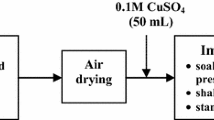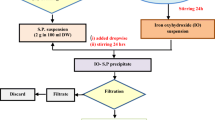Abstract
Uptake of Sr(II) from simulated low level radioactive waste, employing radiotracer 85+89Sr, has been carried out with humic acid by a batch equilibration biosorption study. The process exhibited rapid kinetics and at optimized parameters, Sr(II) was biosorbed from simulated reactor and reprocessing waste by 84 ± 2% and 75 ± 2% respectively. Kinetic modelling revealed that the process follows Ho and McKay’s linear pseudo second order kinetics, indicating chemisorption mechanism of binding. Thermodynamic studies ascertain the exothermic, spontaneous and feasible nature of the process. This work proved the viability of humic acid for Sr(II) removal as an eco-friendly, cost effective alternative to conventional techniques.





Similar content being viewed by others
References
Adams JP (1996) Selected radionuclides important to low level radioactive waste management, 1st edn. U.S. Department of Energy, Idaho
Ojovan MI, Lee WE (2014) An introduction to nuclear waste immobilization, 2nd edn. Elsevier, Amsterdam
Schmidt GR, Sutliff TJ, Dudzinski LA (2011) radioisotope power: a key technology for deep space exploration, radioisotopes—applications in physical sciences In: Singh N (ed) IntechOpen. https://doi.org/10.5772/22041
Giannakopoulou F, Haidouti C, Chronopoulou A, Gasparatos D (2007) Sorption behavior of cesium on various soils under different pH levels. J Hazard Mater 149(3):553–556
Dahiya S, Tripathi RM, Hegde AG (2008) Biosorption of heavy metals and radionuclide from aqueous solutions by pre-treated arca shell biomass. J Hazard Mater 150(2):376–386
Pangeni B, Paudyal H, Inoue K (2014) Development of low cost adsorbents from agricultural waste biomass for the removal of Sr(II) and Cs(I) from water. Waste Biomass Valor 5:1019–1028
Balintova M, Demcak S, Pagacova B (2016) A study of sorption heavy metals by natural organic sorbents. Int J Energy Environ 10:189–194
Chakraborty D, Maji S, Bandyopadhyay A, Basu S (2007) Biosorption of cesium-137 and strontium-90 by mucilaginous seeds of Ocimum basilicum. Bioresour Technol 98(15):2949–2952
Ghorbanzadeh S, Tajer P, Ghazvini M (2009) Bioresource technology biotechnological potential of Azolla filiculoides for biosorption of Cs and Sr: application of micro-PIXE for measurement of biosorption. Bioresour Technol 100(6):1915–1921
Krishna MVB, Arunachalam J, Murali MS, Kumar S, Manchanda VK (2004) Performance of immobilized moss in the removal of 137Cs and 90Sr from actual low-level radioactive waste solutions. J Radioanal Nucl Chem 261(3):551–557
Pipiska M, Hornik M, Kociova M, Augustin J, Lesny J (2005) Radiostrontium uptake by lichen Hypogymnia physodes. Nukleonika 50:39–44
Metwally S, Rizk H, Gasser M (2017) Biosorption of strontium ions from aqueous solution using modified eggshell materials. Radiochim Acta 105(12):1021–1031
Fuks L, Oszczak A, Dudek J, Majdan M, Trytek M (2016) Removal of the radionuclides from aqueous solutions by biosorption on the roots of the dandelion (Taraxacum officinale). Int J Environ Sci Technol 13(10):2339–2352
Barot NS, Bagla HK (2012) Biosorption of radiotoxic 90Sr by green adsorbent: dry cow dung powder. J Radioanal Nucl Chem 294(1):81–86
Liu M et al (2014) Biosorption of strontium from simulated nuclear wastewater by scenedesmus spinosus under culture conditions: adsorption and bioaccumulation processes and models. Int J Environ Res Public Health 11(6):6099–6118
Khani M, Pahlavanzadeh H, Alizadeh K (2012) Biosorption of strontium from aqueous solution by fungus Aspergillus terreus. Environ Sci Pollut Res 19(6):2408–2418
Yin Y, Wang J, Yang X, Li W (2017) Removal of strontium ions by immobilized saccharomyces cerevisiae in magnetic chitosan microspheres. Nucl Eng Technol 49(1):172–177
Dabbagh R, Ghafourian H, Nabi G, Riahi H (2007) Bioaccumulation and biosorption of stable strontium and 90Sr by Oscillatoria homogenea cyanobacterium. J Radioanal Nucl Chem 272(1):53–59
Ghazvini P, Mashkani S, Ghafourian H (2007) Biosorption of strontium from aqueous solution by new strain Bacillus sp. GTG-83. In: WM’07 33rd annual waste management conference, Tucson, AZ
Zhao Y, Dai Q, Dong F, Han L, Yan W (2016) Strontium removal by montmorillonite - pseudomonas fluorescens system. J Microbiol Biotechnol 5(2):39–45
Icgen B, Yilmaz F (2018) Biosorption of strontium from aqueous solutions by Micrococcus luteus Sr02. Geomicrobiol J 35(4):284–293
Wang S, Mulligan CN (2009) Enhanced mobilization of arsenic and heavy metals from mine tailings by humic acid. Chemosphere 74(2):274–279
Sounthararajah DP, Loganathan P, Kandasamy J, Vigneswaran S (2015) Effects of humic acid and suspended solids on the removal of heavy metals from water by adsorption onto granular activated carbon. Int J Environ Res Public Health 12(9):10475–10489
dos Santos A, Botero W, Bellin I, de Oliveira LC, Rocha JC, Mendonca A, Godinho A (2007) Interaction between humic substances and metallic ions: a selectivity study of humic substances and their possible therapeutic application. J Braz Chem Soc 18(4):824–830
Ma M, Wei Y, Zhao G, Liu F, Zhu Y-R (2014) Characterization and adsorption mechanism of Pb(II) removal by insolubilized humic acid in polluted water. Int J Environ Prot Policy 2(6):230–235
Yanti I, Winata WF, Sudiono S Triyono modification of humic acid by ether functional group as biosorbent to Au(III) adsorption in the presence of Sn(II) and Ni(II). In: AIP conference proceedings, 1823(1)
Boguta P, Sokołowska Z (2016) Interactions of Zn(II) ions with humic acids isolated from various type of soils. Effect of pH, Zn concentrations and humic acids chemical properties. PLoS ONE 11(4):e0153626
Paulenova A, Rajec P, Zemberyova M, Sasköiova G, Visšacky V (2000) Strontium and calcium complexation by humic acid. J Radioanal Nucl Chem 246(3):623–628
Macasek F, Shaban IS, Matel L (1999) Cesium, strontium, europium (III) and plutonium (IV) complexes with humic acid in solution and on montmorillonite surface. J Radioanal Nucl Chem 241(3):627–636
Helal AA, Imam DM, Khalifa SM, Aly HF (1998) Effect of some environmental ligands and fertilizers on humic acid complexation with strontium. J Radioanal Nucl Chem 232:9–11
Rupiasih NN, Vidyasagar PB (2009) Analytical study of humic acid from various sources commonly used as fertilizer: emphasis on heavy metal content. Int J Des Nat Ecodyn 4(1):32–46
Kerndorff H, Schnitzer M (1980) Sorption of metals on humic acid. Geochim Cosmochim Acta 44:1701–1708
Vinkler P, Lakatos B, Meisel J (1976) Infrared spectroscopic investigations of humic substances and their metal complexes. Geoderma 3:231–242
Boggs S, Livermore D, Seltz MG (1985) Humic substances in natural waters and their complexation with trace metals and radionuclides: a review. Macromol Chem, Phys
Mani AGS, Paramasivan K, Chitra S, Sinha PK, Lal KB (2005) Improved chemical precipitation process for the treatment of radioactive liquid waste from reprocessing plant. In: Nuclear and radiochemistry symposium (NUCAR), pp 341–342
Kore G, Prasad V, Mishra A (2002) Removal of Ru along with Cs & Sr from the low level radioactive liquid waste of reprocessing plant by chemical treatment method, BARC Newsl (2): 64–69
Hevesy G, Paneth F (1913) The solubility of lead sulphide and lead chromate”. Zeitschrift für Anorg und Allg Chemie 82:323–328
Ho YS, Mckay G (1999) Pseudo-second order model for sorption processes. Process Biochem 34:451–465
Din M, Mirza M, Ata S, Athar M, Mohsin I (2013) Thermodynamics of biosorption for removal of Co(II) ions by an efficient and ecofriendly biosorbent (Saccharum bengalense): kinetics and isotherm modeling. J Chem 2013:1–11
King P, Rakesh N, Beena S, Prsanna Y, Prasad VSRK (2008) Biosorption of zinc onto Syzygium cumini L.: equilibrium and kinetic studies. Chem Eng J 144(2):181–187
Mishraa PC, Patel RK (2009) Removal of lead and zinc ions from water by low cost adsorbents. J Hazard Mater 168(1):31–325
Thavamani SS, Rajkumar R (2013) Removal of Cr(VI), Cu (II), Pb(II) and Ni (II) from aqueous solutions by adsorption on alumina. Res J Chem Sci 3(8):44–48
Author information
Authors and Affiliations
Corresponding author
Ethics declarations
Conflict of interest
The authors declare that they have no conflict of interest.
Additional information
Publisher's Note
Springer Nature remains neutral with regard to jurisdictional claims in published maps and institutional affiliations.
Electronic supplementary material
Below is the link to the electronic supplementary material.
Rights and permissions
About this article
Cite this article
Khan, A.N., Bagla, H.K. Application of tracer technique in remediation of Sr(II) from simulated low level radioactive waste. J Radioanal Nucl Chem 322, 193–198 (2019). https://doi.org/10.1007/s10967-019-06514-9
Received:
Published:
Issue Date:
DOI: https://doi.org/10.1007/s10967-019-06514-9




